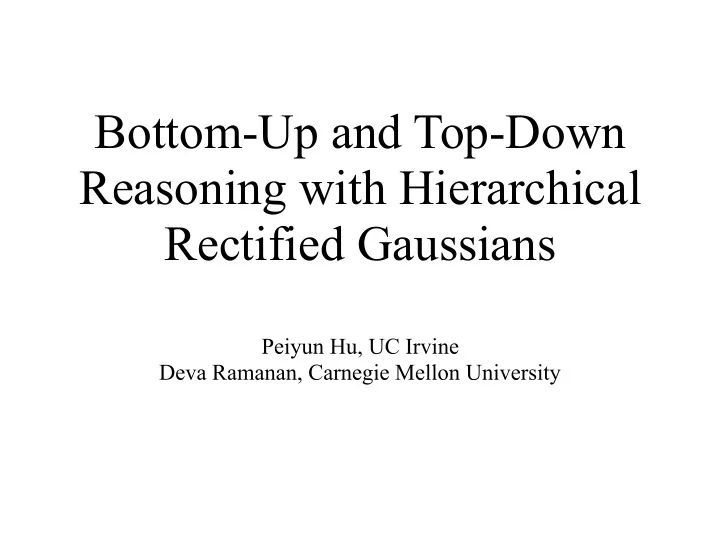

Bottom-Up and Top-Down Reasoning with Hierarchical Rectified Gaussians Peiyun Hu, UC Irvine Deva Ramanan, Carnegie Mellon University
Inspiration from human vision Top-down Feedback Bottom-Up Feedforward We explore efficient bidirectional networks that combine bottom-up and top-down feedback Hu & Ramanan, “Bottom-Up and Top-Down Reasoning with Hierarchical Rectified Gaussians”
Activations with feedback Feedforward activations (layer 1) ~ 1ms Average Feedforward + feedback activations (layer 1) ~ 40ms Feedback appears to add knowledge about the “hair” Hu & Ramanan, “Bottom-Up and Top-Down Reasoning with Hierarchical Rectified Gaussians”
Activations with feedback Feedforward activations (layer 1) ~ 1ms Average Feedforward + feedback activations (layer 1) ~ 40ms Average Feedback appears to add knowledge about the “hair” Hu & Ramanan, “Bottom-Up and Top-Down Reasoning with Hierarchical Rectified Gaussians”
Preview of results Single-scale CNN Hierarchical Probabilistic Model Multi-scale CNN y y y . . . . . . . . . image image image “Fully-convolutional” “Multi-layer” VGG “Top-down” VGG VGG (No increase in parameters) Long et al, 15 Hu & Ramanan, “Bottom-Up and Top-Down Reasoning with Hierarchical Rectified Gaussians”
Preview of results Multi-scale CNN y y y . . . . . . . . . image image image “Fully-convolutional” “Skip” “Top-down” VGG VGG VGG (No increase in parameters) Long et al, 15 Long et al, 15 Hu & Ramanan, “Bottom-Up and Top-Down Reasoning with Hierarchical Rectified Gaussians”
Preview of results Single-scale CNN Hierarchical Probabilistic Model Multi-scale CNN y y y . . . . . . . . . image image image “Fully-convolutional” “Skip” “Top-down” VGG VGG VGG No increase in parameters Long et al, 15 Long et al, 15 Hu & Ramanan, “Bottom-Up and Top-Down Reasoning with Hierarchical Rectified Gaussians”
Preview of results Bottom-up Top-down Hu & Ramanan, “Bottom-Up and Top-Down Reasoning with Hierarchical Rectified Gaussians”
Preview of results Bottom-up Top-down Hu & Ramanan, “Bottom-Up and Top-Down Reasoning with Hierarchical Rectified Gaussians”
So how do we add feedback to deep models? CNNs Past work on CNNs + feedback: Pinherio & Collobert, 14 Cao et al, 15 Gatta et al, 14 Hu & Ramanan, “Bottom-Up and Top-Down Reasoning with Hierarchical Rectified Gaussians”
So how do we add feedback to deep models? CNNs The Rectified Gaussian Distribution 353 (a) (b) Boltzmann Machines Rectified Gaussians Socci et al, 98 Figure 2: The competitive distribution for two variables. (a) A non-convex energy Hu & Ramanan, “Bottom-Up and Top-Down Reasoning with Hierarchical Rectified Gaussians” function with two constrained minima on the x and y axes. Shown are contours of constant energy, and arrows that represent the negative gradient of the energy. (b) The rectified Gaussian distribution has two peaks. The rectified Gaussian happens to be most interesting in the nonconvex case, pre- cisely because of the possibility of multiple minima. The consequence of multiple minima is a multimodal distribution, which cannot be well-approximated by a stan- dard Gaussian. We now consider two examples of a multimodal rectified Gaussian. COMPETITIVE DISTRIBUTION 4 The competitive distribution is defined by -dij + 2 Aij (5) b = 1; (6) i We first consider the simple case N = 2. Then the energy function given by X2 +y2 E(x,y)=- +(x+y)2_(x+y) 2 (7) has two constrained minima at (1,0) and (0,1) and is shown in figure 2(a). It does not lead to a normalizable distribution unless the nonnegativity constraints are imposed. The two constrained minima of this nonconvex energy function correspond to two peaks in the distribution (fig 2(b)). While such a bimodal distribution could be approximated by a mixture of two standard Gaussians, a single Gaussian distribution cannot approximate such a distribution. In particular, the reduced probability density between the two peaks would not be representable at all with a single Gaussian. The competitive distribution gets its name because its energy function is similar to the ones that govern winner-take-all networks[9]. When N becomes large, the N global minima of the energy function are singleton vectors (fig 3), with one component equal to unity, and the rest zero. This is due to a competitive interaction between the components. The mean of the zero temperature distribution is given by (8) The eigenvalues of the covariance 1 1 (XiXj) - (Xi)(Xj) = N dij - N2 (9)
Insight: Use CNNs to learn Hierarchical Rectified Gaussians Unroll MAP updates on Rectified Gaussian models into a rectified neural net Similar architectures: Past work on unrolling models: Chen et al, 15 Autoencoders, DeConvNets, Zheng et al, 15 U-Nets, Hourglass Nets, Ladder Networks Goodfellow et al, 13 Hu & Ramanan, “Bottom-Up and Top-Down Reasoning with Hierarchical Rectified Gaussians”
Empirical results: Caltech Occluded Faces Localization error on occluded points: Bottom-up: 21.3 % Top-down: 15.3 % Improvement comes “for free” (no increase in parameters) Hu & Ramanan, “Bottom-Up and Top-Down Reasoning with Hierarchical Rectified Gaussians”
Take-home messages Add top-down feedback into CNNs “for free” • Unfold inference on rectified probabilistic models into rectified neural nets • Competitive accuracy on keypoint localization • Caltech Occluded Faces MPII Hu & Ramanan, “Bottom-Up and Top-Down Reasoning with Hierarchical Rectified Gaussians”
Recommend
More recommend